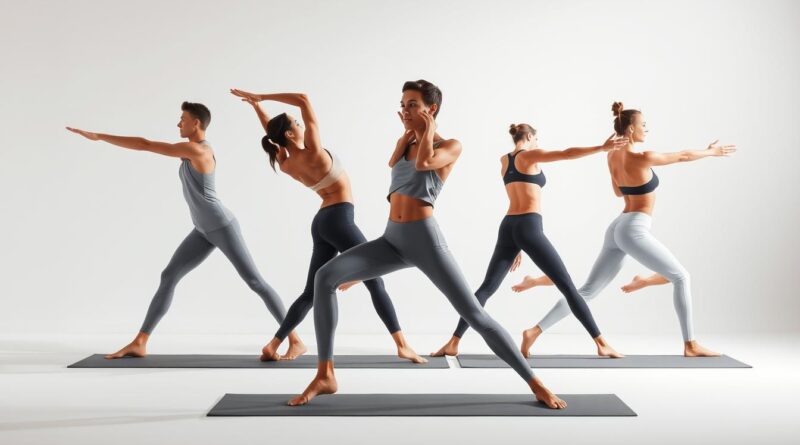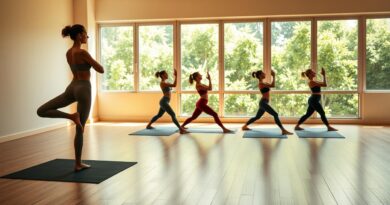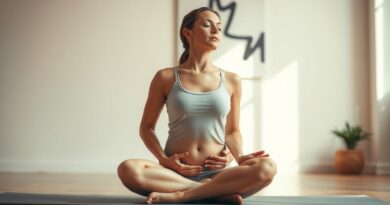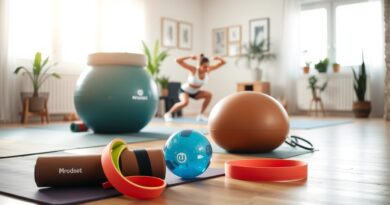Boost Flexibility with This 5-Minute Daily Full Body Stretch Routine
Daily full body stretch routine can completely transform how you feel and move every day. By adding daily stretching exercises into your lifestyle, you’ll experience better flexibility, improved posture, and reduced muscle tension.
This simple full-body flexibility routine works even if you’re short on time. A few minutes of daily stretches for all muscle groups can boost your energy, improve your movement, and support long-term health. Whether you’re looking for a gentle stretch routine for beginners or a more complete flexibility practice, consistency is the key to becoming stronger and more mobile.
Key Takeaways
- Improve your range of motion with regular stretching.
- Enhance your posture and reduce muscle tension.
- Boost your energy levels and overall well-being.
- Make stretching a part of your daily routine for lasting benefits.
- Experience a transformative impact on your overall health.
The Importance of Daily Stretching
Adding daily stretching to your routine boosts your flexibility and well-being. It not only betters your physical health but also helps calm your mind and lower stress.
How Flexibility Impacts Overall Health
Flexibility is key to staying healthy. Being flexible means fewer injuries and easier daily tasks. It also means better posture, less muscle tension, and better blood flow.
Benefits of Consistent Stretching Practice
Regular stretching brings many advantages, including:
- Improved Range of Motion: It keeps or increases joint flexibility.
- Reduced Muscle Tension and Pain: Stretching eases muscle tightness and pain.
Improved Range of Motion
Daily stretches for all muscle groups enhance your range of motion. This makes moving and doing activities easier. It’s great for athletes or those with tough jobs.
Reduced Muscle Tension and Pain
Daily stretching exercises can greatly reduce muscle tension and pain. Stretching relaxes tight muscles and boosts blood flow to sore spots.
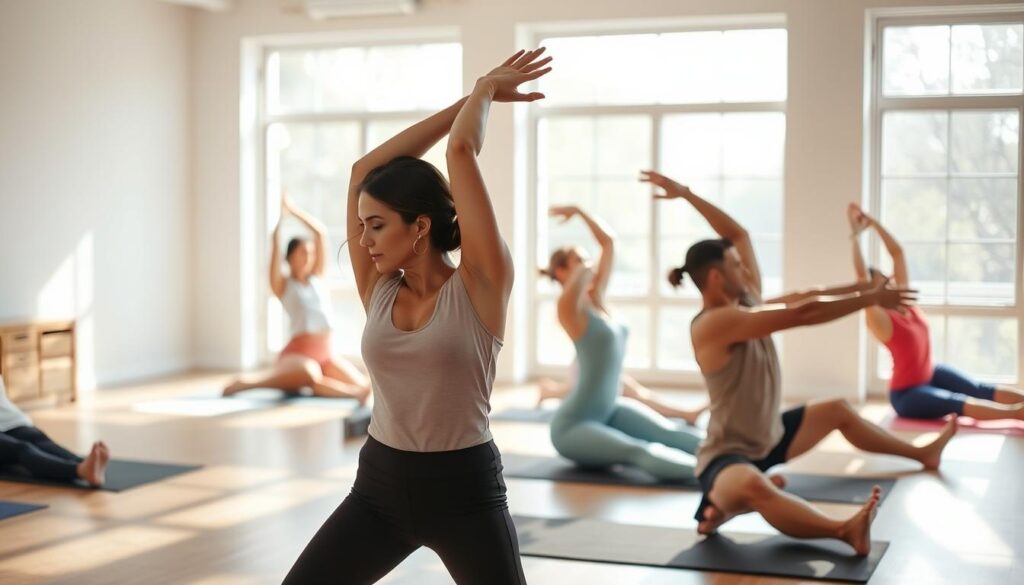
Understanding Your Body’s Flexibility Needs
To get the most from your daily stretch routine, knowing your body’s flexibility needs is key. This knowledge lets you customize your stretch routine for beginners to target tight spots and boost flexibility.
Identifying Your Tight Areas
Start by finding out where you’re tight. Common spots include the hamstrings, hip flexors, and lower back. Knowing these areas helps you focus your flexibility exercises for daily use where they’re needed most.
Setting Realistic Flexibility Goals
Setting goals is important for staying motivated and tracking your progress. Think about what you want to achieve, like better range of motion or less muscle soreness. Clear goals keep you on track with your daily stretching.
Assessing Your Current Flexibility Level
Check your current flexibility with simple tests like touching your toes or stretching your arms up. This self-check gives you a starting point to measure how far you’ve come. Use the table below to track your progress:
| Flexibility Test | Initial Assessment | After 2 Weeks | After 4 Weeks |
|---|---|---|---|
| Touching Toes | Fingers to Knees | Fingers to Calves | Palms to Floor |
| Arm Overhead Stretch | Moderate Stretch | Deep Stretch | Very Deep Stretch |
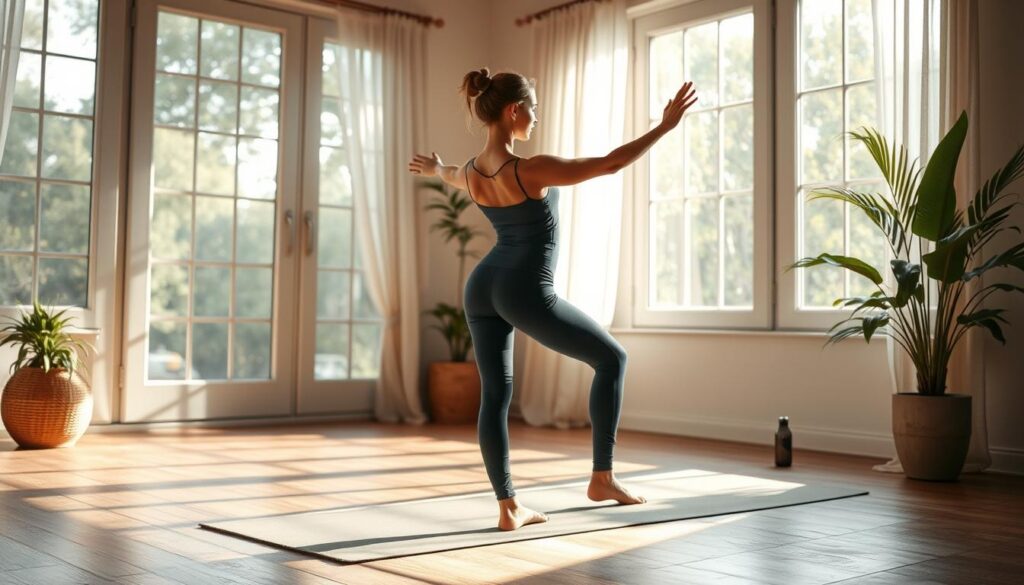
Understanding your body’s flexibility needs lets you craft a stretching routine that’s just right for you. This personalized approach boosts your flexibility and brings daily stretching’s many benefits.
Preparing for Your Daily Full Body Stretch Routine
To get the most out of your daily full body stretch routine, proper preparation is key. This means setting up the right space, getting the right gear, and picking the best time to stretch.
Creating the Right Environment
A quiet, comfy, and tidy space is perfect for stretching. Make sure the room is just right in temperature to help you relax. Use a non-slip mat to avoid slips and keep stable during stretches.
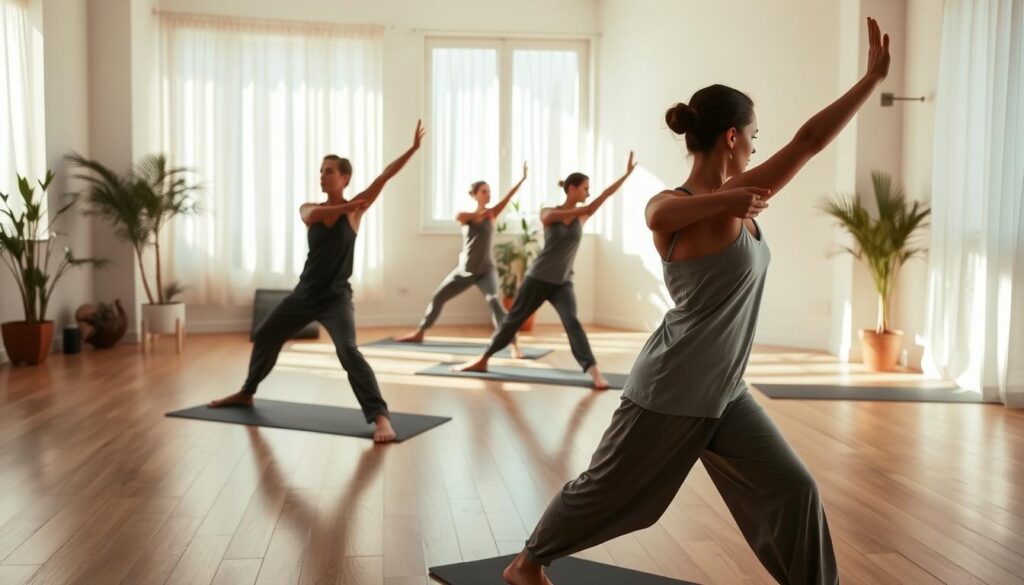
Essential Equipment for Effective Stretching
Stretching can be done with little gear, but some tools can make it better. A stretching strap can deepen your stretches. A foam roller helps release muscle tension. Wear comfy clothes that let you move freely.
Best Times of Day to Stretch
The best time to stretch varies based on your schedule and what feels right. Many like a 10-minute morning stretch routine to boost energy and start the day right. Others stretch in the evening to relax before bed. Try different times to see what suits you best.
Being consistent is important. Try to stretch at the same time every day to make it a regular habit.
Warm-Up Exercises Before Stretching
To get the most out of your stretching, start with a warm-up. It’s key to get your body ready. Warming up helps improve flexibility and lowers injury risk.
Dynamic Movement Preparation
Dynamic movements are great for getting your muscles ready for stretching. They match the actions you’ll do in your stretching routine. This boosts blood flow and warms your muscles.
Circulation-Boosting Activities
Activities that boost circulation are essential. They make sure your muscles get enough oxygen and nutrients. This includes both light cardio and exercises for joint mobility.
Gentle Cardio Options
Light cardio, like jogging or cycling, is good for warming up. It raises your heart rate and improves blood flow. Do 5-10 minutes of gentle cardio to warm up.
Joint Mobility Exercises
Exercises for joint mobility help keep or improve joint range. Simple movements can greatly improve your flexibility and get you ready for stretching.
| Warm-Up Activity | Duration | Benefits |
|---|---|---|
| Light Jogging | 5 minutes | Increases heart rate, improves circulation |
| Joint Rotations | 3-5 minutes | Enhances joint mobility, reduces stiffness |
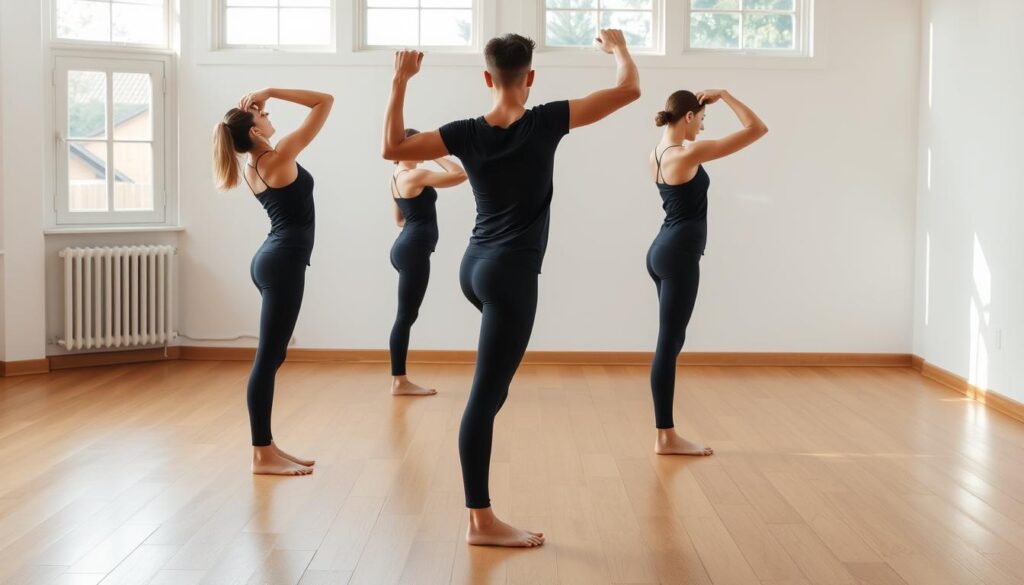
Adding these warm-up exercises to your daily routine prepares you for stretching. It maximizes the benefits of your stretching exercises.
Upper Body Stretches for Daily Practice
Adding upper body stretches to your daily routine boosts flexibility and well-being. Focus on the neck, shoulders, arms, chest, and back. This helps lower muscle tension and boosts movement.
Neck and Shoulder Release Techniques
Many people, especially desk workers, face neck and shoulder tension. Simple stretches can offer a lot of relief.
Neck Rolls and Tilts
Roll your head from side to side, bringing your ear to your shoulder. Then, tilt your head to the side, bringing your chin to your shoulder. Hold each stretch for a few seconds and repeat.
Shoulder Circles and Shrugs
Hold your arms straight out to the sides and make small circles with your hands. Increase the circle size as you go. Shrug your shoulders towards your ears and then release, repeating the motion.
Arm and Chest Opening Stretches
Stretching your arms and chest can improve your posture and reduce muscle tension.
Doorway Chest Stretch
Stand in a doorway with your hands on the doorframe at shoulder height. Lean forward until you feel a stretch in your chest and shoulders.
Triceps and Biceps Stretches
Hold one arm straight out behind you and pull your hand towards your shoulder blade with the other arm, stretching your triceps. For your biceps, hold your arm straight out in front of you and pull your hand back with the other arm, stretching your biceps.
Back Mobility Exercises
Improving back mobility boosts flexibility and lowers injury risk.
Cat-Cow Stretch
Start on your hands and knees. Arch your back, lifting your tailbone and head towards the ceiling (cat pose). Then, round your back, tucking your chin towards your chest and your tailbone towards the floor (cow pose). Repeat several times.
Child’s Pose Variations
Kneel on the ground with your knees wide apart. Sit back onto your heels and stretch your arms out in front of you, lowering your forehead to the ground. You can vary this pose by stretching your arms out to the sides or bringing them back alongside your body.
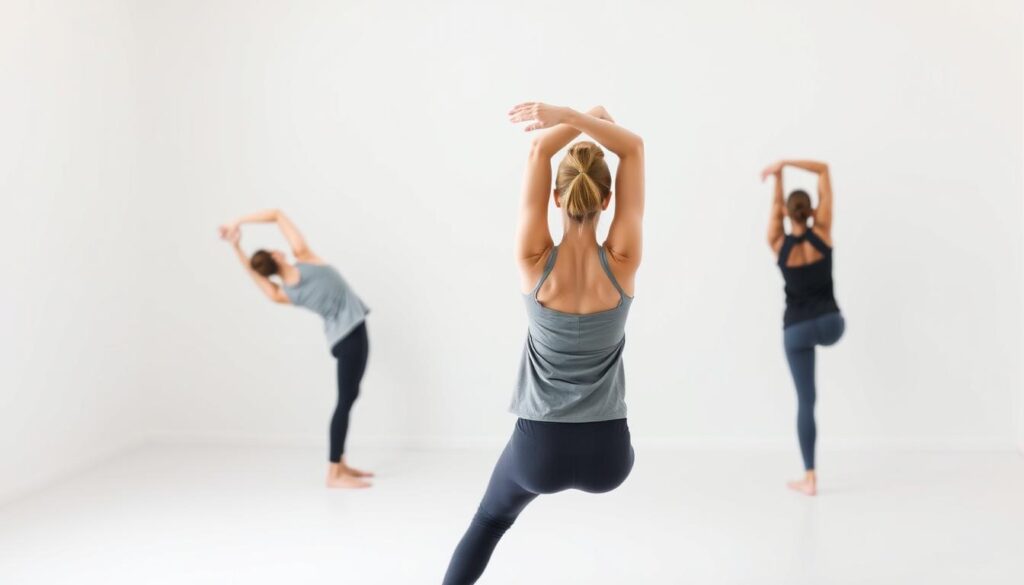
| Stretch | Target Area | Benefits |
|---|---|---|
| Neck Rolls and Tilts | Neck | Relieves tension, improves flexibility |
| Shoulder Circles and Shrugs | Shoulders | Reduces tension, enhances mobility |
| Doorway Chest Stretch | Chest and Shoulders | Improves posture, reduces muscle tension |
| Triceps and Biceps Stretches | Arms | Enhances flexibility, reduces muscle tension |
| Cat-Cow Stretch | Back | Improves mobility, reduces stiffness |
| Child’s Pose Variations | Back and Shoulders | Stretches and relaxes the back, improves flexibility |
By adding these upper body stretches to your daily routine, you can boost flexibility, reduce muscle tension, and improve overall well-being.
Lower Body Stretching Sequence
Adding lower body stretches to your daily routine boosts flexibility. A good lower body stretching sequence is key for a full body flexibility routine. It improves mobility and lowers injury risk.
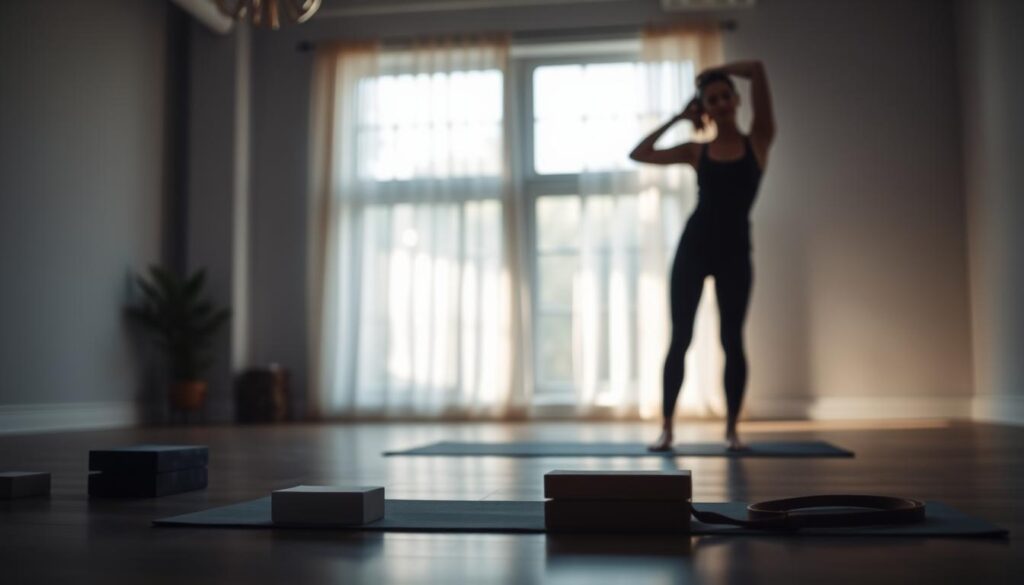
Hip Flexor and Quad Stretches
Tight hip flexors and quads can limit your movement and affect your posture. Specific stretches for these areas can make your flexibility exercises more effective.
Lunging Hip Flexor Stretch
The lunging hip flexor stretch targets the hip flexors well. Stand with feet hip-width apart, take a big step forward with one foot, and lower your body until your back knee almost touches the ground. Keep your front thigh parallel to the floor and hold for 30 seconds before switching legs.
Standing and Lying Quad Stretches
Quad stretches can be done standing or lying down. For a standing quad stretch, stand on one leg and pull your other heel towards your buttocks, holding onto a wall for balance if needed. For a lying quad stretch, lie on your side and pull your top leg’s heel towards your buttocks. Hold each for 30 seconds and switch legs.
Hamstring and Calf Flexibility Moves
Hamstrings and calf muscles are key for mobility and stability. Stretching these areas regularly boosts your overall flexibility.
Forward Fold Variations
Forward folds are great for stretching the hamstrings. Stand with your feet hip-width apart, then bend forward at the hips, reaching for your toes. Hold for 30 seconds. You can bend your knees slightly to ease tension on the hamstrings.
Seated Hamstring Stretches
Seated hamstring stretches involve sitting on the floor with your legs straight out in front of you. Lean forward, reaching for your toes, and hold for 30 seconds.
Ankle Mobility Exercises
Ankle mobility is often overlooked but is vital for overall lower body flexibility. Simple exercises can improve ankle mobility.
Ankle Circles and Point-Flex
Ankle circles involve rotating your ankles in both clockwise and counterclockwise directions. The point-flex exercise involves pointing your toes and then flexing them back. Repeat each exercise 10-15 times.
Calf Raises and Drops
Calf raises involve standing on the edge of a step and raising up onto your tiptoes before lowering back down. This exercise stretches the calf muscles and improves ankle mobility.
By adding these lower body stretches to your daily routine, you can boost your flexibility exercises for daily use. This contributes to a comprehensive full body flexibility routine.
Core and Spine Mobility Stretches
To boost flexibility and lower injury risk, add core and spine stretches to your daily full body stretch routine. These moves improve spinal health, increase motion range, and boost overall health.
Rotational Stretches for Torso
Rotational stretches keep the torso flexible and reduce stiffness. They’re key for better twisting and turning.
Seated and Standing Twists
Seated twists stretch the spine and hips. Standing twists work the whole torso. For a seated twist, sit with feet on the floor and twist to one side. Keep feet and hips straight. For a standing twist, stand with feet apart and twist, keeping hips straight.
Thread the Needle Pose
This pose stretches the spine and shoulders. Start on hands and knees. Reach one arm under the other, twisting and stretching shoulders and upper back.
Lower Back Release Techniques
Lower back release techniques ease tension and prevent pain. Adding these stretches to your daily stretching exercises boosts spinal health.
Knee-to-Chest Stretches
This stretch eases lower back tension. Lie on your back, bring one knee to your chest, and hold. You can stretch both knees for a deeper stretch.
Supine Spinal Twists
Do supine spinal twists lying on your back with knees bent and feet flat. Twist your knees to one side, keeping shoulders down, and hold. This stretch releases spine and hip tension.
Adding these stretches to your daily routine boosts flexibility, cuts back pain, and improves spinal health. Practice these stretches often as part of your daily full body stretch routine for best results.
Implementing Your Daily Full Body Stretch Routine
Starting a daily full body stretch routine can change your flexibility and well-being. Let’s look at how to fit this routine into your daily life.
Morning vs. Evening Stretching Benefits
Stretching is good at any time, but it has different benefits. Morning stretching boosts your energy and gets your muscles ready for the day. Evening stretching helps you relax and sleep better.
| Time of Day | Benefits |
|---|---|
| Morning | Increased energy, improved flexibility, better preparation for daily activities |
| Evening | Relaxation, improved sleep quality, reduced muscle tension |
10-Minute Quick Routine for Busy Days
If you’re always busy, a 10-minute morning stretch is great. Focus on big muscle groups like hamstrings and hip flexors. This quick routine boosts flexibility and eases muscle tension.
Extended 30-Minute Deep Stretch Session
On days with more time, try a 30-minute deep stretch. It stretches all major muscles, including your back and shoulders. It’s perfect for unwinding and refreshing yourself.
Combining Stretching with Other Fitness Activities
Stretching works well with yoga or Pilates to improve flexibility and strength. You can also add it to your daily routine, like during work breaks or after exercising.
Common Mistakes and How to Avoid Them
Stretching every day is great, but you might be making mistakes. Knowing these common errors can help you get the most from your stretching routine.
Improper Stretching Techniques
Using the wrong technique is a big mistake. It can make stretching less effective or even hurt you. Make sure you’re stretching the right muscles and not straining your joints too much.
Breathing Patterns During Stretches
Proper breathing is key when stretching. Use deep, controlled breaths to relax into the stretch. Don’t hold your breath, as it can cause tension.
| Stretching Technique | Common Mistake | Correct Approach |
|---|---|---|
| Neck Stretch | Stretching too far or too fast | Gently tilt your head, holding for 30 seconds |
| Hamstring Stretch | Bending at the waist instead of the hips | Keep your back straight, bending at the hips |
When to Hold vs. When to Move
Knowing when to hold a stretch and when to move is important. Hold static stretches for 15-30 seconds to relax the muscles fully.
Signs You’re Pushing Too Far
Sharp pain or discomfort means you’re stretching too hard. Stretching should be challenging but not painful. Back off if you feel any bad sensations.
Conclusion
Adding a daily full body stretch routine to your life can really boost your flexibility and health. Knowing what your body needs and sticking to a stretching plan can make a big difference. You’ll see better athletic skills and less muscle tightness.
A good full body stretch routine keeps your joints moving well and helps your posture. It also lowers the chance of getting hurt. Remember, start slow and get deeper and longer with your stretches over time.
Choosing to stretch every day is a smart move for a healthier, more flexible you. So, start now. Begin your path to better flexibility with a stretch routine that fits your life and needs.
FAQ
What is a daily full body stretch routine?
How long should a daily full body stretch routine take?
What are the benefits of a daily stretching practice?
Can I combine stretching with other fitness activities?
How do I know if I’m pushing too far during a stretch?
What is the best time of day to stretch?
Do I need any special equipment for stretching?
Can stretching help with back pain?
Kickstart Your Fitness Journey with This Beginner Full Body Workout

